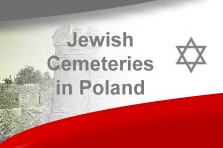In co-operation of 2020 with cmentarze-zydowskie.pl
This page deals with the history of the Jewish community of the town, a detailed description of the cemetery including a short list of names of the remaining gravestones and even describes the plant world on the site, a Polish study from 1996.
Our second page publishes the names of the cemetery register and describes a maintenance action from 2005, the article was first published in Germany – Link >>
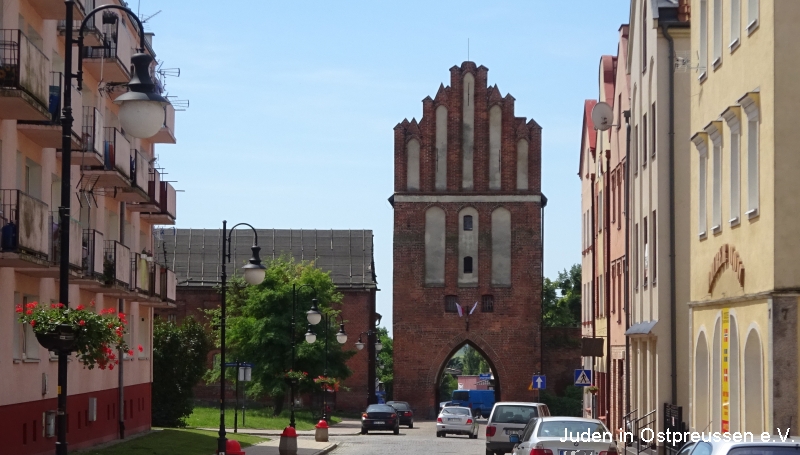
The first information about the stay of Jews in Pasłęk (Preussisch Holland) dates back to 1779, when one of the rich dressmakers – Reple – filed a complaint against Jewish merchants, who were his competitors and thus depleted his income. The presence of the Jews was quite troublesome for the town craftsmen, therefore some restrictions were introduced by local regulations – the Jews could stop in one place for no longer than 24 hours and trade only outside the town gates or in the villages. The Jews who stayed in the town for longer could not trade and usually worked as salaried workers. However, they were also not allowed to settle permanently. An example of such a policy of the authorities was the case of Marx Lemon, who in 1806 applied to the Municipal Board for permission to buy a plot of land for a two-storey residential house. This application was rejected. This was the case until March 11, 1812, when an edict was issued, which allowed Jews to settle permanently in Prussia and equated them with other citizens. In connection with the granting of citizenship, certain obligations were imposed on them: every Jew had to establish and certify his family name; all documents had to be in German or another living language, and signatures had to be in Gothic or Latin alphabet.
The following Jews came to Pasłęk (Preussisch Holland) first: Lewin Tobias Lindenheim (1813), Nothan Joseph Furst (1813), Bohr Joseph Furst (1813), Joseph Salomon Isenheim (1813), Marcus Jontof Stolpin (1813), Jacob Gollschalch Rosenberg (1814), Aron Dawid Arenheim (1814), Joseph Aleksander Furst (1814), Joseph Jinking Isenheim (1816), Suskimi Girach Ladendorf (1816).
Nearly all the Jews were engaged in trade, some of them gained considerable wealth and were respected. The Aris family was particularly well-known. They mastered the local grain trade and managed the Jewish community. The Arios lived at 18a Arntsfreihen Street – today’s Augustyna Steffena Street. Unfortunately, this house has not been preserved.
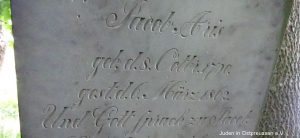 Heinrich Aris was the head of the Pasłęk (Preussisch Holland) Jewish community, while Samuel Aris was one of three members of the committee of the Grain Exchange, founded in 1871 and located on the ground floor of the Hotel Deutsches Haus in Pasłęk (Preussisch Holland). Samuel Aris contributed to his family’s control of the local grain trade. From 1857, the Aris family also dominated the trade in leather and textiles, and one of its representatives worked as a real estate broker. Only Heinrich Rias managed to obtain a fortune and capital in the amount of one million marks, which made him the richest citizen of Pasłęk (Preussisch Holland). H. Aris could afford to build the largest and most beautiful house in the city. His importance among the urban elite was enormous, he was able to make many people from the aristocracy and landowners dependent on him. After his death on September 18, 1930, the funeral ceremonies were attended by the local landowners and significant citizens of Pasłęk (Preussisch Holland).
Heinrich Aris was the head of the Pasłęk (Preussisch Holland) Jewish community, while Samuel Aris was one of three members of the committee of the Grain Exchange, founded in 1871 and located on the ground floor of the Hotel Deutsches Haus in Pasłęk (Preussisch Holland). Samuel Aris contributed to his family’s control of the local grain trade. From 1857, the Aris family also dominated the trade in leather and textiles, and one of its representatives worked as a real estate broker. Only Heinrich Rias managed to obtain a fortune and capital in the amount of one million marks, which made him the richest citizen of Pasłęk (Preussisch Holland). H. Aris could afford to build the largest and most beautiful house in the city. His importance among the urban elite was enormous, he was able to make many people from the aristocracy and landowners dependent on him. After his death on September 18, 1930, the funeral ceremonies were attended by the local landowners and significant citizens of Pasłęk (Preussisch Holland).
The Lesser family was also known, who lived at Reiterstrasse 5, now Kościuszki Street. The Lessers were mainly involved in the trade of leather goods.
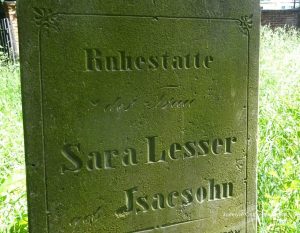 The Jewish community was managed by the religious congregation. On its seal there were two climbed lions supporting the plaque, the crown and the inscription: “Vorstand der Synagogen – Gemeinde zu Pr. Holland”. Under the community’s management there were: a synagogue, a bathhouse, a school and other public buildings. The earliest, because already in 1817 a cemetery and a house of prayer were established. In 1826 a swimming pool was established by the Mill Canal. In 1836 the first synagogue was built, which functioned until 1878, when a brick synagogue was erected. In 1895 a school was established, which was attended by 26 children. It was not until 1892 that a bathhouse was established in one of the houses.
The Jewish community was managed by the religious congregation. On its seal there were two climbed lions supporting the plaque, the crown and the inscription: “Vorstand der Synagogen – Gemeinde zu Pr. Holland”. Under the community’s management there were: a synagogue, a bathhouse, a school and other public buildings. The earliest, because already in 1817 a cemetery and a house of prayer were established. In 1826 a swimming pool was established by the Mill Canal. In 1836 the first synagogue was built, which functioned until 1878, when a brick synagogue was erected. In 1895 a school was established, which was attended by 26 children. It was not until 1892 that a bathhouse was established in one of the houses.
The most important place for the Jewish community was the synagogue. After further changes of its location, a brick object was finally built, whose description can be found in the “Chronicle of Pasłęk” by Fr Kazimierz Cyganek. The synagogue began in the place where Krasickiego Street ends and Dąbrowskiego Street begins. It was a massive brick building. According to Fr. K. Cyganka’s message, the front of the synagogue was seven meters high, with a flat roof sloping to the city wall, brick, on which stood a statue of Moses holding tablets with commandments. In addition, the temple was decorated with an open book of Torah and a plaque with twelve squares, marking twelve tribes of Israel. In the middle of the building, by the gable wall from the street side, an altar cabinet, the so-called Aron ha-Kodesh, was placed, in which seven parchment Torah rolls were kept. Above it there was a gilded inscription in Hebrew with the words “Temple of the Eternal” and the Plaques of Commandments, supported by two gilded lions and an eagle with its wings spread. In front of the altar recess, a bimah was erected with a balustrade and a pulpit with a red tablecloth with the shield of David and the inscription “Magen David” and two candles stood. On both sides of the passage there were benches for men. At the other end of the synagogue, opposite the altar cabinet, there was a women’s choir. Two texts of prayers for the souls of the dead were placed on the walls of the temple in beautiful frames. It was a gift from Dr. Arnheim from Elbląg (Elbing), funded for the opening of the synagogue. For the first time, prayers in the synagogue took place on July 3, 1878, and on July 24, 1878, the opening ceremony took place.
The Jews came to Pasłęk (Preussisch Holland) primarily from Polish lands, Pomerania and the former East Prussia. Due to economic and linguistic connections, the population was probably assimilated quite quickly. In practice, they were distinguished only by their religion and the forms of worship associated with it. In 1864 there were 160 Jews in Pasłęk (Preussisch Holland), in 1880 – 175, later this number was constantly decreasing. The reason for this were probably the difficult economic conditions at the turn of the century and the First World War. In 1903 there were 104 people of Jewish origin in Pasłęk (Preussisch Holland), and in 1933 only 41 people. After the Nazis came to power, the Jews of Pasłęk (Preussisch Holland) were subjected to increasing harassment. The economic boycott intensified and there were attacks on people of Jewish origin. In 1938 the Jewish community was dissolved. The previously sold synagogue building was set on fire during Kristallnacht. Nazi repressions forced the final emigration of Jews from Pasłęk (Preussisch Holland). Some Jews were deported to extermination camps. According to “Encyclopedia of Jewish Life before and during the Holocaust”, there was only one person of Jewish origin living in the town in 1942.
The Jewish cemetery in Pasłęk (Preussisch Holland) was established on the outskirts of the town, on a hill, which was not very suitable for development, which reduced the risk of expropriation for other purposes. The location of the cemetery was probably determined by administrative regulations and economic reasons – the land there was cheaper.
In 1817 the first land for the burial site was purchased. It was a plot of land on today’s Wojska Polskiego Street, bought from the baker Zerloh for 30 thalers. In 1864 another piece of land was bought from the confectioner Zachowski. This two-stage organization of the cemetery was reflected in the distribution of graves: the oldest ones are located in the north-western part; the younger ones – in the southern part. The type of graves and the arrangement of the rows are also noteworthy. In the older part there are earthy graves, in the younger part – graves with terrazzo cover.
Before the end of the 19th century, probably after the expansion of the cemetery area, the whole was surrounded by a massive brick wall, facing one side of the necropolis. This wall was reinforced with pillars, set regularly every 240 centimeters. On the southern side – today’s Wojska Polskiego Street – an entrance gate was placed, on this side the wall was made of bricks faced on both sides. On the right side of the gate, in the south-eastern corner, the building was preserved, probably used for cemetery purposes, probably as a pre-burial house.
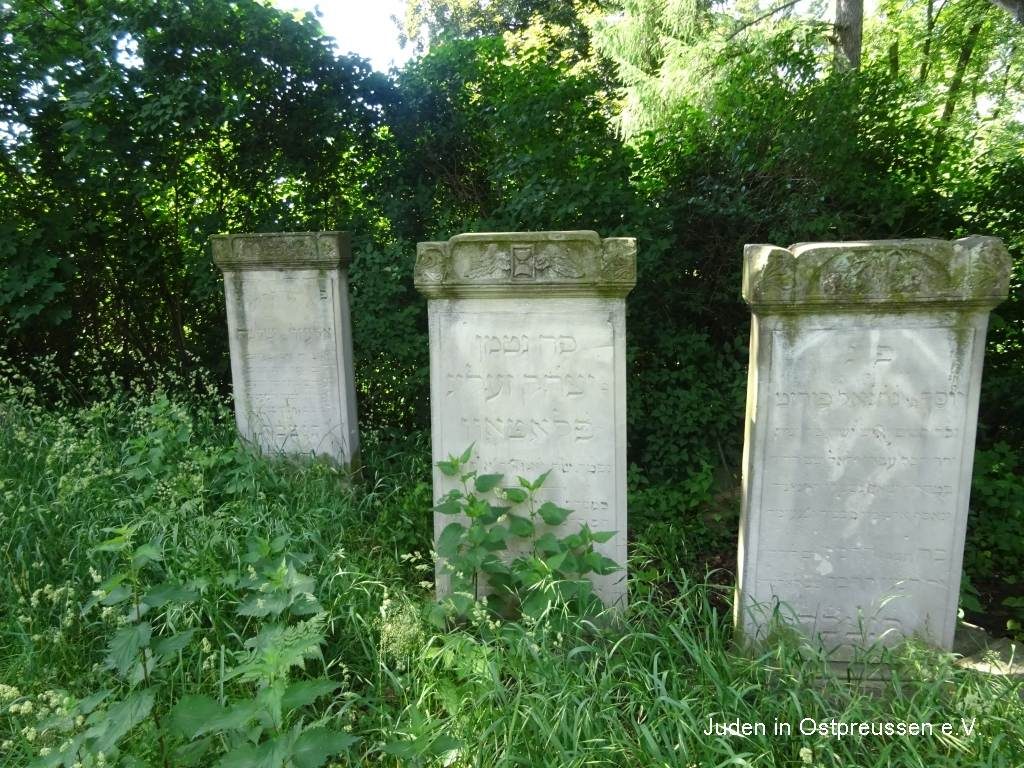
The Pasłęk (Preussisch Holland) Jewish cemetery is one of the best preserved necropolises of the Jewish faith in the region. Although it does not belong to cemeteries of large and advanced age, its historical value is undeniable. It is the last material trace of the existence of the Jewish community in the town and its surroundings.
The cemetery was established in the Pasłęk (Preussisch Holland) suburban area, the only access to it was the original iron gate, located in the southern part of the cemetery wall, from the side of today’s Wojska Polskiego Street. The expansion of the town, which took place in the first half of the 19th century, resulted in closing the access to the cemetery from this side. Such a spatial development of the town’s buildings proves that the cemetery ceased to be used before 1939.
The cemetery plot is shaped like an irregular pentagon. The area used to be 100 x 50 m. The area is much smaller today. The original fence (the wall) has been preserved from the south and east, and an old foundation with a metal grid, belonging to farm buildings, has been stretched over it from the east. From the north there is no protection except a natural slope, about two meters high. This is currently the only access to the cemetery. Below the slope there is a walking linden alley, today neglected.
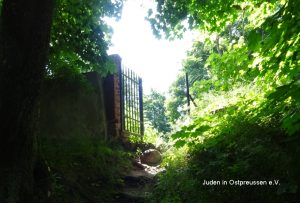
Currently, there are over a hundred burial sites in the cemetery. Only thirty tombstones, mostly made of sandstone, have survived, the rest of which are terrazzo cases or earth graves. Numerous pillars, bases and plinths have also survived. The inscriptions on some of the matzevot are already poorly legible. These are inscriptions in both Hebrew (obverse) and German (reverse), and they also contain time definitions, written according to Hebrew and Gregorian calendars.
Most of the matzevot in the cemetery represent the classicist type, only in some cases it takes on a traditional semicircular shape. The tombstones are orientated in a way characteristic of Jewish 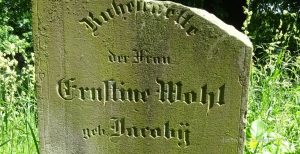 culture – they are placed in the heads of the graves, from the western side. The face of the tombstones is almost in all cases facing the east.
culture – they are placed in the heads of the graves, from the western side. The face of the tombstones is almost in all cases facing the east.
The matzevot were made of sandstone, few – of marble. The latter have been very seriously devastated. The attention is drawn to the rich ornamentation, which has a symbolic and ornamental character. Ornamental ornaments include: stylized frames, plant wreaths, wreaths, roses, feathers and geometric elements; while symbolic motifs include: a winged hourglass and a broken tree as a symbol of death and the Star of David as a symbol of national belonging. One can also find fragments of steles topped with a stone tree as a direct reference to the symbolism of death.
On the surviving matzevot (tomb stones), 21 names could be found
- Aris, Jacob (1790-1862)
- Aris, Pauline (1834-1869)
- Aris, Rebeca (1834-1865)
- Fürst, Gerson (1815-1868)
- Fürst, Veile (1815-1868)
- Goldbaum, …. (?)
- Hadendorf; Ruben (?-1875)
- Hadendorg; Ernstine (1814-1876)
- Katz, Ida (1828-1869)
- Katz, Tobine (1827-1869)
- Korn, Mirna (?)
- Laserstein, Agnes (1857-1860)
- Laserstein, Leopold (1828-1873)
- Lehman, .. (?)
- Lessner, Sara (1826-1870)
- Lewin, Salomon (1852-1902)
- Matow, Serlig (?)
- Oppenheim, Moritz (?)
- Ruhm, Ruben (?)
- Windenbeim, Aron (?) (1797-1879)
- Wohl, Ernstine (1811-1873)
The matzevot were probably made in stone workshops in Elbląg (Elbing) and Braniewo (Braunsberg). This is indicated by signatures found on tombstones: “C. Mathias, Elbing” and “S. Goldbaum, Braunsberg”.
Let’s devote a few words to cemetery greenery. The highest plant floor is formed by deciduous trees. These are mainly: the common maple (Acer platanoides) and the haughty ash (Fraxinus exelsior). These species constitute the most numerous group in the described area. They occur in various forms: from adult, nearly twenty-year-old specimens to young, bushy trees, most often self-seeders. Many small-leaved lime trees (Tilia cordata) also grow in the cemetery. These are usually young trees, the only exception is the majestic, almost two hundred year old lime tree, which – despite the decay – still blooms. We also have a few specimens of aspen (Populus tremula). These trees are the most numerous plant formation in the cemetery.
A smaller percentage of the land is occupied by shrubs. We can list here such specimens as: common lilac (Syringa vulgaris), tuja (Thuja occidentalis) and single-seeded hawthorn (Crataegus monogyna). 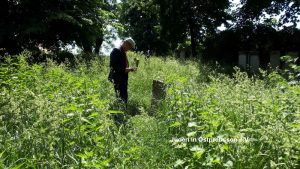 Most of them are self-seeders. They are quite young plants with a compact habit. The condition of trees and shrubs is quite good, there are no dried out or broken branches. Only a few clones have dried out branches.
Most of them are self-seeders. They are quite young plants with a compact habit. The condition of trees and shrubs is quite good, there are no dried out or broken branches. Only a few clones have dried out branches.
The most abundant species forming the cover in the cemetery is common ivy (Hedera helix), covering the entire area. In the undergrowth there are also low shrubs: blackberry (Rubus plicatus) and raspberry (Rubus ideeus). The remaining vegetation is meadow flora. These include various species of grasses (Graminae): the common perch (Agropyron repens), meadow stump (Allopecurus myoseroides), ryegrass (Lolium), mozga (Phalaris) and various types of pansy (Poa) and others.
There are also various species of weeds, for example: thistles (Carduus), nettles (Urtica dioica), stingers (Geranium), camomile (Matricaria), vetches (Vicia). In addition, depending on the season, we can find seasonal vegetation in the cemetery. These will include: anemones (Anemone nemorosa), common snowdrops (Galanthus nivalis) and Anemone hepatica (Hepatica nobilis).
The general state of preservation of the cemetery is rather bad – the reason for this is the lack of adequate protection from the north. This has consequences in the form of devastation of the cemetery itself by littering the land; gravestones that are knocked over or broken, as well as greenery that is 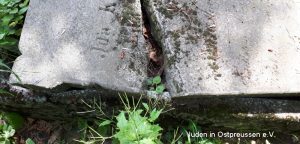 destroyed or thoughtlessly cut out. Some of the matzevot have survived to a good degree, but this is a small group that is constantly decreasing. Some of the steles have been dug out and moved, as shown by the reverse direction of the obverse, the Hebrew inscriptions.
destroyed or thoughtlessly cut out. Some of the matzevot have survived to a good degree, but this is a small group that is constantly decreasing. Some of the steles have been dug out and moved, as shown by the reverse direction of the obverse, the Hebrew inscriptions.
Fragments of broken matzevot can be found all over the cemetery, they are scattered or sunk into the ground. The same is true of the surviving terrazzo shrouds – some of them have been moved, are broken, and the graves bear traces of digging. A slope on the north side is also a serious problem. Recently, the slope has been deprived of its natural turf, which causes a landslide and threatens the group of the best preserved tombstones located on the edge of the cemetery.
The above text is a fragment of the work entitled “The Jewish cemetery in Pasłęk. Historical and conservation study”, prepared in 1996 by students from the Historical Circle operating at the Bohaterów Grunwaldu High School in Pasłęk. Katarzyna Panimasz, M.Sc., took care of the content and editorial supervision, and they made a special contribution to the creation of this study: (…names see original page…) We would like to thank Mrs. Katarzyna Panimasz for agreeing to publish the text on our website.
The website about Pasłęk (Preussisch Holland) Cemetery was created thanks to cooperation with the Internet Forum www.marienburg.pl >>
For more pictures (Stanisław Napiórkowski and B.Jesionowski) of tomb stones in Pasłęk / Preussisch Holland pls. refer to original web page Cmentarze-Zydowski pl >>
To see a detailed list of funeral names for Preussisch Holland from the State Archives in Leipzig, (article by Bettina Müller) please click here to visit our webpage Cemetery Register Preussisch Holland >>
In co-operation of 2020 with cmentarze-zydowskie.pl
